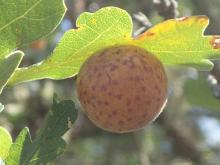Includes aphid, adelgid, eriophyid mite, flies, gall wasp, midge, psyllids and sawflies
Pest description and damage Plant galls are formed in response to an interaction with insects, (as well as mites, nematodes, viruses or fungi) and the plant tissues. Egg-laying, salivary secretions or mechanical injury initiates production of localized plant hormones that cause accelerated growth (larger plant cells or increased number of cells) of the growing tissue. The plant tissue grows around the insect or mite protecting it from weather and natural enemies. Galls can form in the developing tissues of any plant structure including leaves, buds, stems, flowers, shoots or roots. Generally, damage is not significant to the plant but considered unsightly by homeowners. Occasionally, infestations flare up to significant numbers and the plant will form abscission layers that cause infested leaves to drop from the host along with the insects or mites inside. Insect galls rarely kill plants and are heavily parasitized in most years. Low numbers of galls are not harmful to trees.
Several orders of insects have adopted specific gall types, and methods of control will vary with the types:
- Eriophyid mites cause infested tissues to "balloon" such as maple bladder gall mite or linden nipple gall;
- Psyllids or jumping plant lice cause leaf tips or edges to curl like psyllid in boxwood;
- Aphids form the petiole galls on cottonwood or the reddish galls on kinnikinnik;
- Adelgids such as the Cooley spruce gall adelgid form cone like galls on spruce;
- Flies and midges such as honeylocust pod gall midge form beaked willow galls and willow pine cone galls;
- Gall wasps, tiny members of the order Hymenoptera (not stinging wasps), form oak apple galls, thimbleberry galls or other galls; and
- Sawflies (Hymenoptera) commonly form willow pea galls and willow bean galls.
Biology and life history Biology is variable depending on the insect or mite initiating the gall as they oviposit or feed on sensitive plant tissues. Generally, there are two kinds of galls: closed and open. Closed galls form around and enclose the eggs of developing insects (such as tiny flies of the willow pinecone gall, pea gall, honeylocust pod gall midge or rose gall). The enclosed insects must chew their way out of a closed gall. Open galls are formed around sucking insects (or mites) in response to the salivary juices of the insect. These galls have small openings that allow the mites or insects to move in and out of the galls or the galls crack open on drying and free the insects inside. Removing and destroying green galls before adults emerge may break the life cycle.
Chemical control often targets the adults as they emerge from the gall. Alternatively, galls can be removed before the insects have emerged, be placed in baggies in shaded areas, and the adults reared out. When the first adults emerge, insects can be identified at your local Extension office or Master Gardener clinic. Once identification is made, appropriate control measures can be selected. In some cases, emerging insects may be parasitoids that should be conserved, rather than destroyed. Again, proper identification of the emerging insects can assist in choosing proper management.
Pest monitoring Some species with the habit of causing significant damage to their host, such as the honeylocust pod gall midge, can only be controlled when control measures target the adult stage. Thus, monitoring adult insect flight activity with sticky traps and repeated inspection is recommended. Degree-day or phenology models to predict adult flight are available for some gall insect species.
Management-cultural control
Most galls are an interesting partnership between the plant and the gall maker. Rarely are the galls numerous enough to warrant control. Most homeowners find they can tolerate gall insects once they know the plant is not going to die. Prune out or remove galls on infested twigs, buds or leaves if they are objectionable.
Management-biological control
Many gall insects are heavily parasitized once they become numerous enough for parasitoids to locate them. Pick galls and place them in a sealed plastic bag with a bit of tissue to absorb moisture and wait for emergence of gall maker and parasitoids to determine the level of parasitoid activity.
Management-chemical control
See Table 3 in:
Chemical Control of Landscape Pests
For more information
Hahn, J. and M.E. Ascerno. 2018. Insect and Mite Galls. University of Minnesota Extension. (https://extension.umn.edu/yard-and-garden-insects/insect-and-mite-galls)





